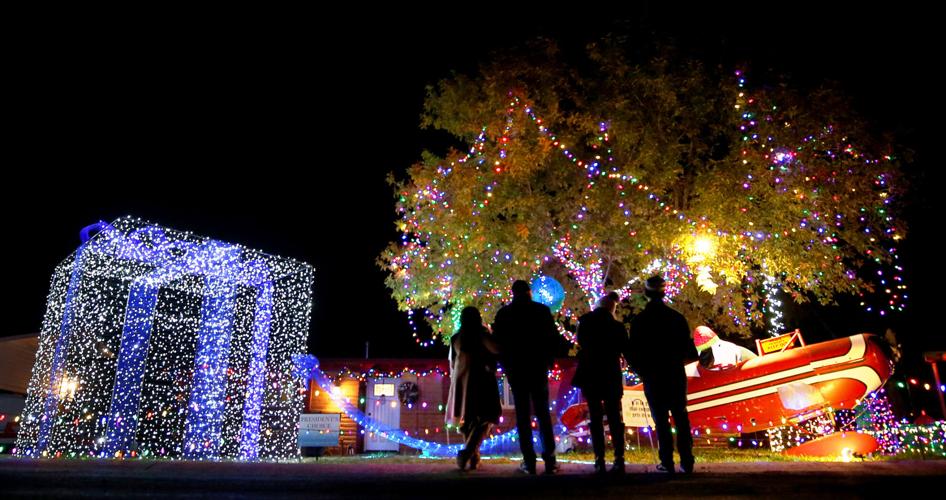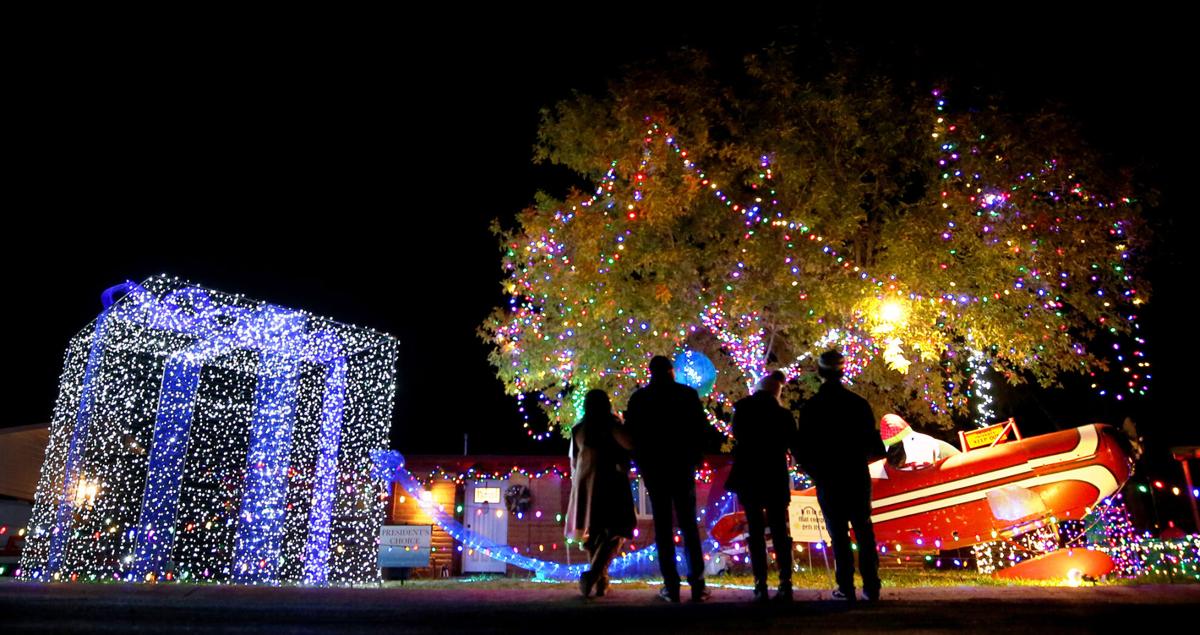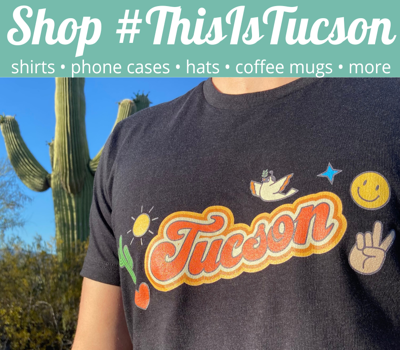Tucson's Winterhaven Festival of Lights has been canceled this year due to COVID-19.
The decision was made in consultation with the City of Tucson and the Pima County Health Department, Winterhaven Festival of Lights Chair Mariel Hall said in a news release.
"We believe what is most important is the safety and well-being of our Tucson community during the continuing COVID-19 pandemic and that holding our traditional event for the community would not serve to ensure that," Hall said.
Winterhaven Rides, which provides hayrides at the event, was told of the cancelation Thursday afternoon by festival organizers, said the company's Julie Wycoff.
This would have been the 71st annual festival in Tucson's north-side Winterhaven neighborhood near East Fort Lowell and North Country Club roads.
“We had been suspecting it and expecting it and we applaud the Winterhaven festival for everything they do, including this decision to try to forego what they love the most, which is of course putting on this festival, for the safety of the community,” Wycoff said.
The cancelation will affect the Southern Arizona Community Food Bank, as the food bank receives donations through the festival, Wycoff noted. She asked Tucsonans to continue to donate to the food bank this holiday season.
There was discussion about hosting drive-thru nights only, however, those events are cumbersome on residents, said Jennifer Pershing, secretary/treasurer for Winterhaven public events.
Pershing said hosting a handful of drive-thru nights didn't make sense given the effort and cost — $75,000 — that goes into decorating the community. Hosting more drive-thrus would make it hard for residents to leave and return to their homes, and the vehicle exhaust would be too much, she said.
Going dark
Each year residents of the neighborhood have decorated their homes with bright lights and elaborate holiday displays for revelers from across the city to enjoy, in the event billed as "Tucson's favorite holiday tradition."
Jeffrey Scott Brown was disappointed when he heard the festival was canceled.
Growing up in Winterhaven, decorating for hundreds of daily visitors has been an important part of his life.
Making it more painful is that the festival will go dark while his father's health is deteriorating, he said.
"This may be his last Christmas with us and we're still going to make it beautiful inside we're still gonna make it homey and comfortable and festive inside," Brown said about his father, Stanley Brown, who is 88 years old and is on oxygen.

Stanley Brown and wife Shirley Brown shown in 2009, their 45th year of decorating their home for the Winterhaven Festival of Lights. Their house is transformed each year during the holidays according to a different theme.
"You know, home is where the heart grows right," he said.
Brown was 4 months old when his parents moved into their Winterhaven home in 1964.
Their first year in the neighborhood, Brown's parents — Shirley and Stanley — decorated their home on East Farr Street with a blow up Santa, four reindeer, three elves and a sled.
Over the years the family has expanded and changed their annual displays, including a space alien themed display in 2019, Jeffrey Brown, their eldest son, said.
They have since moved from the Farr Street home to a home in the heart of the Winterhaven neighborhood, where North Christmas Avenue intersects with East Kleindale Road.
The Browns will still display some decorations outside their home, as many families do during the holidays, Brown said. But they don't plan to go all out like they would for the festival.
Brown said he had expected festival organizers to decide on a drive-thru event this year, but he said he understands why the festival was canceled. It would be difficult to keep people from walking through the neighborhood, and and to enforce a mask mandate and social distancing among large crowds, he said.
"It's a challenge that I don't think the board wanted to take on because of having that, you know, held over you that someone got sick or died after visiting Winterhaven," Brown said. "That's not a good thing. So I think they were just defaulting on the best thing would be to just go ahead and cancel it this year."
This is the second year the festival has been canceled, Brown said.
"It is significant but I think we need to remember that COVID-19 is a significant foe," Brown said, citing the deaths across the U.S. and world.
In 1973, organizers voted to cancel the festival due to the energy crisis, when oil prices skyrocketed and consumers were asked to conserve energy. That year, the Browns placed luminarias outside their home every night for about a week to bring some light to the neighborhood. Other neighbors followed suit, Brown said.
A community experience
The festival was started in 1949 by Winterhaven's original developer, C.B. Richards, after he visited similar neighborhood light displays in Beverly Hills, California, Arizona Daily Star archives show.
He designed the whole neighborhood with the hope it would be able to host a big holiday festival like the one visited by many thousands here every year.
So many people attend the event sponsored by Tucson Electric Power that in the last couple of years, it has collected about 60,000 pounds of food each holiday season for the food bank.
The Community Food Bank issued a statement of support for the decision to cancel the event, saying it puts "the health and safety of our community first during this pandemic."
“We will miss this festive holiday tradition, and the food drive that accompanies it,” said Michael McDonald, CEO of the Community Food Bank of Southern Arizona. “As we continue to see job losses and families struggling in this economy, we do encourage people to donate online or to sign up to volunteer and help distribute food this holiday season at communityfoodbank.org. We join the Winterhaven neighborhood in the hope of healthier and brighter times ahead.”
Visitors to last year’s Winterhaven Festival of Lights donated nearly 50,000 pounds of food and nearly $25,000 to fight hunger in the Tucson area.
Looking ahead
Festival organizers said they hope to be able to hold the event safely for the 2021 holiday season.
In the mean time, to ensure the community is aware of the cancellation and to minimize non-resident traffic in the neighborhood, the city will provide traffic control barricades and signage.
The organizers also encourage community members to support the food bank.
Photos: Tucson's Winterhaven Festival of Lights through the years
Winterhaven Festival of Lights
Updated
Winterhaven Festival of Lights in Tucson in December, 1964. Time exposure at Christmas Ave. and McKenzie St.
Winterhaven Festival of Lights
Updated
Winterhaven Festival of Lights in Tucson in December, 1964.
Winterhaven Festival of Lights
Updated
Winterhaven Festival of Lights in Tucson in December, 1964.
Winterhaven Festival of Lights
Updated
Winterhaven Festival of Lights in Tucson in December, 1964.
Winterhaven Festival of Lights
Updated
Winterhaven Festival of Lights in Tucson in December, 1966.
Winterhaven Festival of Lights
Updated
Time exposure of Luminaria Lane in the Winterhaven subdivision in Tucson in December, 1961. Residents along Greenlee Road and Stewart Avenue placed hundreds of traditional Mexican luminarias around their homes.
Winterhaven Festival of Lights
Updated
Winterhaven Festival of Lights in Tucson in December, 1966.
Winterhaven Festival of Lights
Updated
Winterhaven Festival of Lights in Tucson in December, 1966.
Winterhaven Festival of Lights
Updated
Winterhaven Festival of Lights in Tucson in December, 1966.
Winterhaven Festival of Lights
Updated
Winterhaven Festival of Lights in Tucson in December, 1968.
Winterhaven Festival of Lights
Updated
Winterhaven Festival of Lights in Tucson in December, 1971.
Winterhaven Festival of Lights
Updated
Winterhaven Festival of Lights in Tucson in December, 1971.
Winterhaven Festival of Lights
Updated
Winterhaven Festival of Lights in Tucson in December, 1971.
Winterhaven Festival of Lights
Updated
Winterhaven Festival of Lights in Tucson in December, 1971.
Winterhaven Festival of Lights
Updated
Winterhaven Festival of Lights in Tucson in December, 1971.
Winterhaven Festival of Lights
Updated
A single vehicle drives through the Winterhaven neighborhood in Tucson on Christmas Eve, 1956.
Winterhaven Festival of Lights
Updated
Entrance to the Winterhaven Festival of Lights in Tucson in December, 1971.
Winterhaven Festival of Lights
Updated
Winterhaven Festival of Lights in Tucson in 1968.
Winterhaven Festival of Lights
Updated
Winterhaven Festival of Lights in Tucson in December, 1972.
Winterhaven Festival of Lights
Updated
Winterhaven Festival of Lights in Tucson in December, 1972.
Winterhaven Festival of Lights
Updated
Winterhaven Festival of Lights in Tucson in December, 1972.
Winterhaven Festival of Lights
Updated
Winterhaven Festival of Lights in Tucson in December, 1974.
Winterhaven Festival of Lights
Updated
Winterhaven Festival of Lights in Tucson in December, 1974.
Winterhaven Festival of Lights
Updated
Winterhaven Festival of Lights in Tucson in December, 1974.
Winterhaven Festival of Lights
Updated
Winterhaven Festival of Lights in Tucson in December, 1964. Time exposure at Christmas Ave. and McKenzie St.






